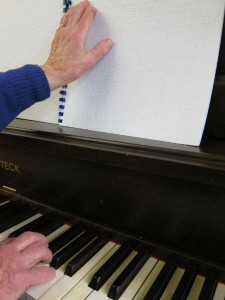Learning music is like learning a new language. So, for the people who are blind or have low vision, braille is their gateway to reading music.
Blind jazz musician Nelson Rufatt and braille music transcriber Jordie Howell are this week’s guests on Vision Australia Radio’s Talking Vision, sharing their experiences as mentors at the annual Braille Music Camp.
Listen to the full interview in the player below:
Running for more than 40 years, the camp started off as an opportunity to teach children braille code, but has transformed into a huge annual event.
“It has become so much more… groups singing in harmony, writing arrangements for each other, improvising together, it really is just magic,” Nelson said.
Knowing when to repeat a chorus or play different parts of a song more loudly or quietly is extremely important to musicians, so for those who can’t see, braille code can be hugely helpful.
“It looks to the normal eye just like braille combinations of six dots,” Jordie said.
“To the braille reader the letters, abbreviations and contractions resemble the music notes.
“The top four dots of the braille itself make the pitch of a note and the bottom two notes add to the duration.”

Image: Braille piano music.
Learning braille music opened more advanced avenues for Nelson who had learned to play instruments by ear.
He was able to arrange and transcribe music, and ‘sight read’ when singing.
“It wasn’t really until I started singing in a choir that I started using braille music,” he said.
This year’s Braille Music Camp won’t be going ahead due to COVID-19 restrictions, but the organisers hope to add some virtual concerts on YouTube from previous years’ highlights and feature compositions from students at home.
Talking Vision is a weekly discussion of issues relating to blindness and low vision.
It includes stories of inspiration and achievement and information on services for the community.
Tell us your story by emailing [email protected]










